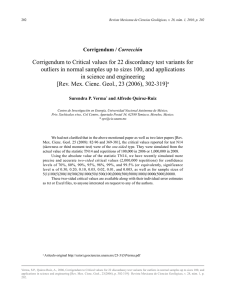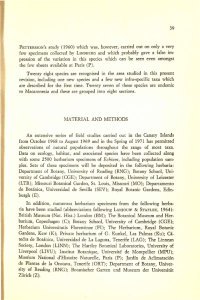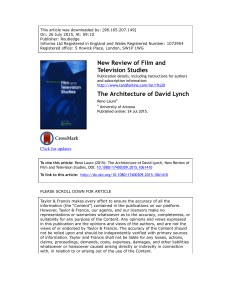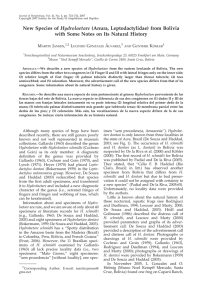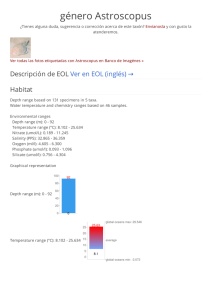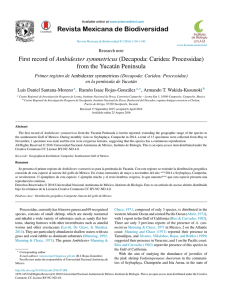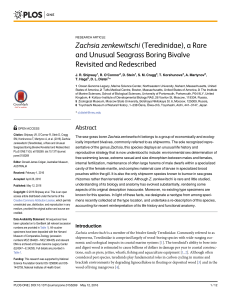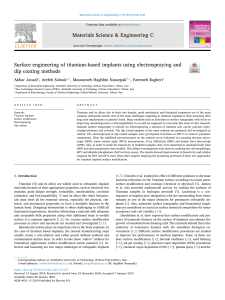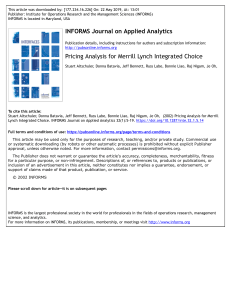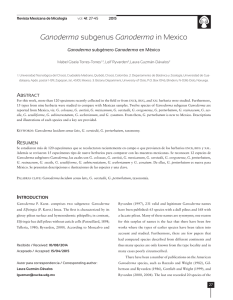discovery of oscaecilia polyzona
Anuncio
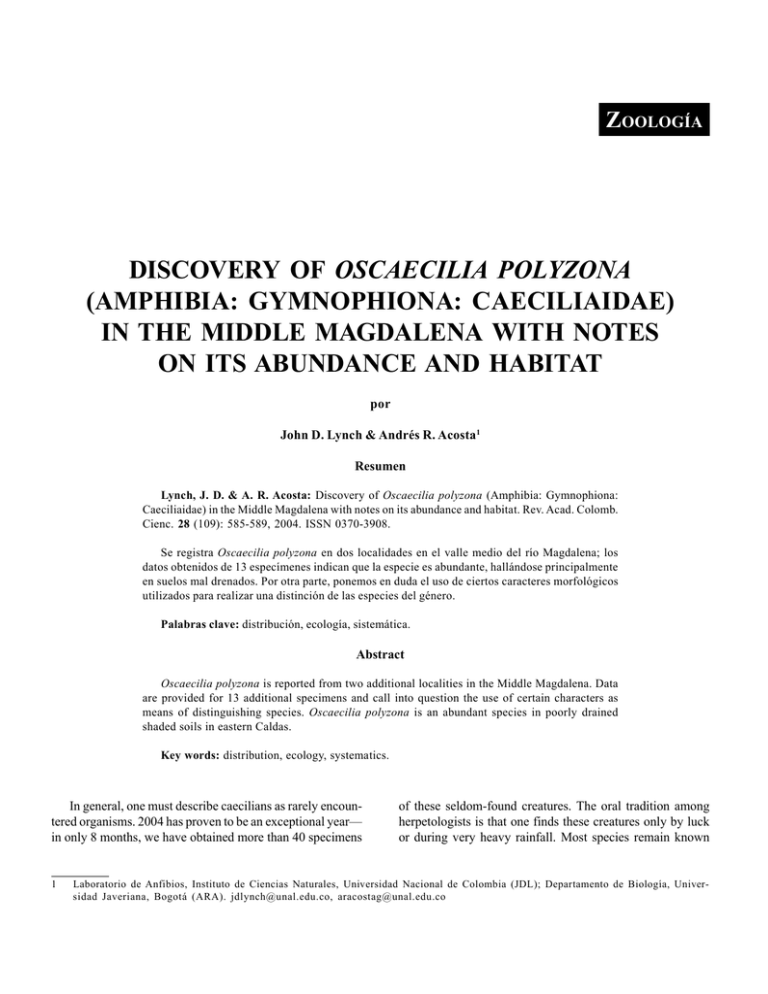
LYNCH, J. D. & A. R. ACOSTA: DISCOVERY OF OSCAECILIA POLYZONA (AMPHIBIA: GYMNOPHIONA. . . 585 ZOOLOGÍA DISCOVERY OF OSCAECILIA POLYZONA (AMPHIBIA: GYMNOPHIONA: CAECILIAIDAE) IN THE MIDDLE MAGDALENA WITH NOTES ON ITS ABUNDANCE AND HABITAT por John D. Lynch & Andrés R. Acosta1 Resumen Lynch, J. D. & A. R. Acosta: Discovery of Oscaecilia polyzona (Amphibia: Gymnophiona: Caeciliaidae) in the Middle Magdalena with notes on its abundance and habitat. Rev. Acad. Colomb. Cienc. 28 (109): 585-589, 2004. ISSN 0370-3908. Se registra Oscaecilia polyzona en dos localidades en el valle medio del río Magdalena; los datos obtenidos de 13 especímenes indican que la especie es abundante, hallándose principalmente en suelos mal drenados. Por otra parte, ponemos en duda el uso de ciertos caracteres morfológicos utilizados para realizar una distinción de las especies del género. Palabras clave: distribución, ecología, sistemática. Abstract Oscaecilia polyzona is reported from two additional localities in the Middle Magdalena. Data are provided for 13 additional specimens and call into question the use of certain characters as means of distinguishing species. Oscaecilia polyzona is an abundant species in poorly drained shaded soils in eastern Caldas. Key words: distribution, ecology, systematics. In general, one must describe caecilians as rarely encountered organisms. 2004 has proven to be an exceptional year— in only 8 months, we have obtained more than 40 specimens 1 of these seldom-found creatures. The oral tradition among herpetologists is that one finds these creatures only by luck or during very heavy rainfall. Most species remain known Laboratorio de Anfibios, Instituto de Ciencias Naturales, Universidad Nacional de Colombia (JDL); Departamento de Biología, Universidad Javeriana, Bogotá (ARA). [email protected], [email protected] 586 REV. ACAD. COLOMB. CIENC.: VOLUMEN XXVIII, NÚMERO 109-DICIEMBRE DE 2004 only from the original description (Nussbaum & Wilkinson, 1989). Oscaecilia polyzona (Fisher) is a case in point. The original three cotypes were collected in 1879 in Cáceres, Antioquia, and a century was to pass before an additional, incomplete, specimen was obtained at Juradó, Chocó (Lynch, 2000). Here we report 13 additional specimens from the Magdalena valley as well as observations on the habitat and abundance of the species. The new specimens are between 326 and 668 mm total length and exhibit 196 to 209 (x = 203.1) primary surci as well as 5 to 26 (x = 19.2) secondaries contrasting with the data provided by Taylor (1968:615-619) where he reported (in the diagnosis) “Primaries, approximately 202-206, few secondaries (10-17).” However, in his text, the primary counts were 203, 206 and 209 with 10-13 secondaries. Wake (1984) initiated the presentation of minute detail in a species description and was followed uncritically by Lahanas & Savage (1992). In each case, they described a species based upon single examples (hence, perhaps, the attention to detail). We took all those data for each specimen in an attempt to evaluate characters. We are unable to relate the number of secondaries to body size (granted, over a limited range of sizes—32.6 to 66.8 cm total length) nor can we do so with any of the tooth counts (maxillary-premaxillary 6-6 to 9-9, x = 7.88.0 [minimum-maximum values]; vomeropalatine 4-6 to 9-10, x = 6.7-7.3; dentary 6-8 to 9-10, x = 7.7-8.0; splenial teeth 4 to 6, x = 5.2) or for the number of annuli interrupted by the vent (1-3, x = 2.0). MUJ 3375 had the most teeth (18 maxillary-premaxillary, 19 vomeropalatines, and 5 splenials) but is not the largest specimen examined. The size of the largest scales varies from 1.7 X 0.8 mm in MUJ 3375 (596 mm total length) to 1.0 X 0.6 mm in ICN 48000 (326 mm) and 48002 (610 mm). There is a single row of scales in each groove. Species currently classified as Oscaecilia exhibit some notable differences in terms of the point of scale inception-O. elongata lacks scales (Dunn, 1942), in O. ochrocephala and O. polyzona, Taylor (1968) reported scale inception at “about primary 26” and at primary 18 in O. bassleri. The remaining species show scale inception much further posteriorly (between primaries 90 to 113 in O. equatorialis, O. hypereumeces, O. koepckeorum, and O. zweifeli and at primary 175 in O. osae; Lahanas & Savage (1992), Taylor (1968, 1969), and Wake (1984). This character appears to be reported for counts made of single individuals and we were curious what might result from taking the data point for each specimen (whether or not there is a character here [bearing in mind the argu- ments of Grant & Kluge, 2004] remains to be seen). In our specimens of O. polyzona, scale inception occurs between primary 17 and primary 36 but principally between primary 20 and 23. Individuals between 40 and 67 cm total length exhibit little variation (primaries 17 to 28, x = 22.1). The exceptional specimen (ICN 48000) is the smallest specimen examined (32.6 cm total length), suggesting that there may be an ontogenetic component to the character termed scale inception (Fig. 1). Obviously, there is no linear relationship here but we need more juveniles to detect a curvilinear correlation. The index of attenuation varies between 46 and 72 (x = 54.9) and there is a tendency (significantly different from zero) for the index to increase with body size (Fig. 2). Using the published records (Lynch, 2000) one obtains a particular view as to the distribution of the species almost consonant with Taylor’s (1969) opinion that polyzona is a subspecies of O. ochrocephala but the new records establish the presence of the species well to the south in the Magdalena valley (Fig. 3). Lahanas & Sav- Figura 1. Scale inception versus total length in Oscaecilia polyzona. Figura 2. Attenuation index versus total length in Oscaecilia polyzona. LYNCH, J. D. & A. R. ACOSTA: DISCOVERY OF OSCAECILIA POLYZONA (AMPHIBIA: GYMNOPHIONA. . . 587 Figura 3. Distributions of Oscaecilia ochrocephala (square) and O. polyzona (circles) in Colombia. Open symbols represent literature records. 588 REV. ACAD. COLOMB. CIENC.: VOLUMEN XXVIII, NÚMERO 109-DICIEMBRE DE 2004 age (1992) distinguished O. ochrocephala and O. polyzona, in part, for the presence of an unsegmented terminal shield in O. polyzona and its absence in O. ochrocephala. The two species are very similar in coloration (Taylor, 1968) (however, see below) but O. polyzona is slightly larger and there is no overlap in primary counts (169-189 in O. ochrocephala [correcting Lahanas & Savage, 1992, Savage & Wake, 2001; pers. comm. Jay M. Savage to JDL, 20 Aug. 2004] and 196-209 in O. polyzona). collect caecilians. In the case of O. polyzona, we have additional evidence gathered by the junior author when he accompanied some of his students on a fieldtrip to eastern Caldas earlier this year. Based on his recollections of our fieldwork in 1999 when we collected caecilians (Parvicaecilia nicefori) in abundance at Venadillo, Tolima, he elected to do some digging in what he saw as a particularly attractive spot (Fig. 4). He was able to “rob” only a half an hour from his student but succeeded in capturing ten O. polyzona. Interviews with fishermen at La Dorada reveal that this species (presumably; actually, we envision as many as five terrestrial species of caecilians may be so exploited there) is used as bait for catfish and is available in local markets for that purpose. That a terrestrial caecilian is sold commercially as fish bait, suggests that the species is a common one-at variance with the collective “knowledge” of herpetologists who viewed as ludicrous our excursions to In the course of evaluating these specimens we made a silly error of temporarily confusing Caecilia thompsoni for Oscaecilia polyzona (relying upon color pattern to identify specimens-see Fig. 4). Aside from the obvious differences in the visibility of the eye, the species are readily distinguished in that Caecilia thompsoni has more primaries in some populations (Lynch, 2000; Taylor, 1968) and its head is not so cone-shaped (the sides of the Figura 4. A. Caecilia thompsoni (MUJ 0000, female, 67.2 cm); B-C. Oscaecilia polyzona (MUJ 3375, female, 65.9 cm); D. Habitat of Oscaecilia polyzona in eastern Caldas. Photos by Andrés Acosta. LYNCH, J. D. & A. R. ACOSTA: DISCOVERY OF OSCAECILIA POLYZONA (AMPHIBIA: GYMNOPHIONA. . . head in C. thompsoni are more nearly parallel) as in O. polyzona. In life, O. polyzona was described as follows: upper and lateral surfaces of head pink; body with gray grooves, folds gray-brown and small yellow-white flecks; throat pink, body with gray-brown rings on cream background (fieldnotes of the junior author). A remarkable aspect in O. polyzona is the change in coloration during its preparation process-its coloration in formaldehyde is generally dark blue-gray above and cream-blue ventrally-once transferred to ethanol, the dorsal surfaces turn pale brown and the ventral surfaces salmon. Ecological notes are available for 12 of the recently obtained specimens. The Río Manso reserve contains remants of the original wet tropical forest with an undulating relief where low ridges are forested but the flat areas have been converted into pastureland. Oscaecilia polyzona was found in areas moderately inclined (ca 25° of slope) in very wet soils (bogs) lacking rocks, covered with palms and trees reaching 10 m high and an understory of herbaceous vegetation. Specimens examined: Antioquia: Maceo, Las Brisas, 500 m (MHUA 2680); Caldas: La Dorada, vereda San Roque, Reserva Natural Privada Río Manso, 210 m 5° 39’ N, 74° 46’ W (ICN 47997-48002, 48040-41, MUJ 337377); Chocó: Juradó (UVC 8351). Acknowledgments The junior author thanks Carolina Huertas, Jairo Moreno and Johan Peña for assistence in the field. Permision to carry out fieldwork was given by the Jaramillo family, especially Ana María Jaramillo, at the Private Reservation Riomanso. Mónica Donuyer and Oscar Ospina (CORPOCALDAS) provided permits for collecting. We thank Fernando Castro (Museo de Historia Natural, Universidad del Valle-Cali, UVC) for loan of 589 material and Vivian Páez (Museo de Herpetología, Universidad de Antioquia-Medellín, MHUA) for providing working space. Jay M. Savage provided JDL with clarifications concerning his publications on the allied O. ochrocephala. Specimens identified as ICN are in the Instituto de Ciencias Naturales and those by MUJ in the Museo de la Universidad Javeriana. Literature cited Dunn, E. R. 1942. The American caecilians. Bulletin of the Museum of Comparative Zoology, Harvard University, 91: 439-540. Grant, T. & A. G. Kluge. 2004. Transformation series as an ideographic carácter concept. Cladistics 20: 23-31. Lahanas, P. N. & J. M. Savage. 1992. A new species of caecilian from the Península de Osa in Costa Rica. Copeia 1992: 703708. Lynch, J. D. 2000 [“1999”]. Una aproximación a las culebras ciegas de Colombia (Amphibia: Gymnophiona). Rev. Acad. Colomb. Cienc. Exactas, Físicas y Naturales 23 (suplemento): 317-337. Nussbaum, R. A. & M. Wilkinson. 1989. On the classification and phylogeny of caecilians (Amphibia: Gymnophiona), a critical review. Herpetological Monographs (3): 1-42. Savage, J. M. & M. H. Wake. 2001. Reevaluation of the status of taxa of Central American caecilians (Amphibia: Gymnophiona), with comments on their origin and evolution. Copeia 2001: 52-64. Taylor, E. H. 1968. The Caecilians of the World/ A Taxonomic Review. University of Kansas Press. __________. 1969. A caecilian miscellany. University of Kansas Science Bulletin 50(5): 187-231. Wake, M. H. 1984. A new caecilian from Peru (Amphibia: Gymnophiona). Bonner Zoologische Beiträge 35: 213-219. Recibido el 1° de octubre de 2004 Aceptado para su publicación el 14 de octubre de 2004 590 REV. ACAD. COLOMB. CIENC.: VOLUMEN XXVIII, NÚMERO 109-DICIEMBRE DE 2004
